Painting | Ancient Frescoes and Paintings | Graphics | Sculpture | Mosaic | Stained-Glasses | Tapestryand Embroidery | Objets d'art | Photography | Asian Arts
Art and Wine in Asia: China, Korea, and Japan

THE GIRL COMMONLY CALLED UNCONTROLLABLE (detail)
Japan, Kitagawa Utamaro, ca. 1802
Woodblock print, encre et couleur sur papier, 36.7 x 23.5 cm
Honolulu Museum of Art, Hawaii, United States
CHINA
While wine is usually defined as an alcoholic drink produced through the fermentation of grapes grown on cultivated vines, this was not the case in Ancient China. From the Neolithic period (over 3000 years BC), it's known that Chinese people made an alcoholic drink from fermented cereals such as millet and wheat. This beverage was known as jiu. As no exact equivalent for this term exists, it's generally translated as wine, despite not coming from the fermentation of grape juice. This particular practice arrived later – around the 4th century BC – with the introduction of cultivated vines, Vitis vinifera, from central Asia*. The grape-based wine produced from this point onwards is also called jiu, a term used for the many sorts of wine which coexisted for centuries: cereal-, grape- and fruit-based wines together.
Among the many US, English, Chinese and French museums whose artworks linked to wine are displayed here, few indicate what type of wine is depicted. When these pieces date from before the 4th century BC, it's almost certainly cereal-based; when they're more recent than this, it's sometimes difficult to know. But really, what does it matter?
* Via the Silk Road, a network of roads and sea routes used for the transport of goods. These trading routes would dominate East-West exchanges for centuries. The oldest known traces of the Silk Road, used for communication with Western peoples, date back to “at least 2000 BC” (Lucette Boulnois, Les routes de la soie, Sciences humaines, April 2009).
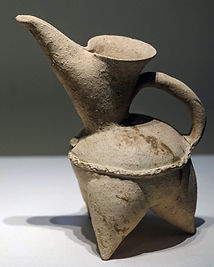
VESSEL (IUG)
Dawenkou culture, initial phase
3500-3000 BC.
White pottery guy; 15.2 cm
National Museum of China

ZUN WINE VESSEL OF THE YAXU CLAN
Shang Dynasty, 13th/12th c. BC.
Bronze
H. 39.1 cm
National Palace Museum, Taipei, Taiwan / 2

CYLINDRICAL ZUN
ca. 12th century BC.
China
Bronze, H. 30.8 cm
British Museum, London / 3

RITUAL RAN-FORM WINE VESSEL, GONG
Shang Dynasty, 13th/11th century BC.
Bronze
L. 22 cm
Private collection?

WINE WESSEL IN THE SHAPE OF AN OWL
Shang Dynasty, 13th-12th century BC.
China
Bronze, H. 31.12 cm, 3.7 kg
Minneapolis Institute of Art,United States
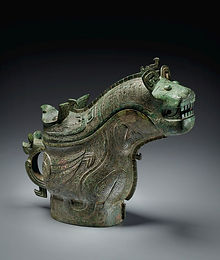
RITUAL WINE VESSEL AND COVER, GONG
Late Shang Dynasty (1600-1046 BC.)
13th-12th century BC.
Bronze, L. 29.8 cm
Private collection?

ZUN IN THE SHAPE OF A BOAR, WINE VESSEL
Shang Dynasty (ca. 1600/ca. 1050 BC.)
H. 40.0 cm, L. 72.0 cm
Bronze
Hunan Provincial Museum, Changsha, China
.png)
ELEPHANT-SHAPED WINE VESSEL ZUN
Shang Dynasty (ca. 1600/ca. 1050 BC.)
H. 22.8 cm
Bronze
Hunan Provincial Museum, Changsha, China
.jpg)
TOU VESSEL IN THE SHAPE OF A FELINE
Shang Dynasty
Between 1100 and 1050 BC..
Bronze, H. 35.2 cm
Cernuschi Museum, Paris
WINE CUP (ZHI)
Western Zhou Dynasty, 11th century BC.
H. 15.2 cm
Bronze
The Metropolitan Museum of Art, New York
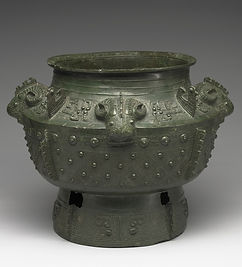
LEI WINE VESSEL WITH GOAT-HEAD HIGH RELIEFS
Late Shang Dynasty, 11th century BC.
H. 37.3 cm
Bronze
National Palace Museum, Taipei, Taiwan
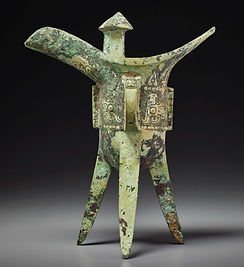
RITUAL WINE VESSEL (JUE)
Late 11th century BC.
Bronze
H. 25,1 cm
The Metropolitan Museum of Art, New York

RITUAL WINE VESSEL (POU)
Late Shang Dynasty, 12th-11th century BC.
L. 33 cm
Bronze
Private collection
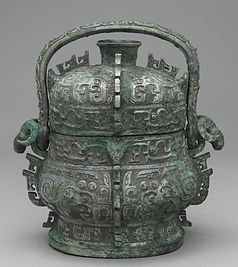
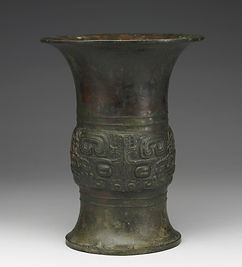
ZUN WINE VESSEL OF YA-QIN TO YI THE FATHER
Shang Dynasty (1600/1046 av. J.-C.)
H. 28 cm
Bronze
National Palace Museum, Taipei, Taïwan
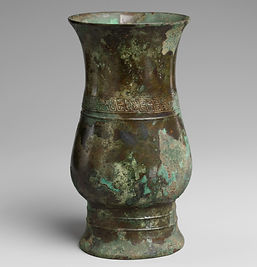
'YOU' COVERED RITUAL WINE VESSEL WITH ELEPHANT
AND 'TAOTIE' DECOR T DE MASQUES "TAOTIE"
Zhou Dynasty, Late 11th-Early 10th century BC.
Bronze, H. 26.9 cm
Harvard Art Museums, Cambridge, United States

ZUN WINE VESSEL TO YI THE GRANDFATHER
Early Western Zhou Dynasty
(1046-771 BC.-1047-957 av. J.-C.)
China, Bronze, H. 34.5 cm
National Palace Museum, Taipei, Taïwan
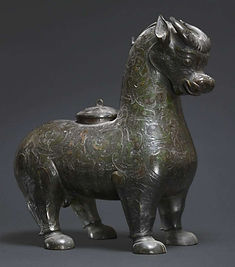
BULL-SHAPED WINE VESSEL
Qing Dynasty, 221/206 BC.
Bronze, gold
H. 33.60 cm
British Museum, London
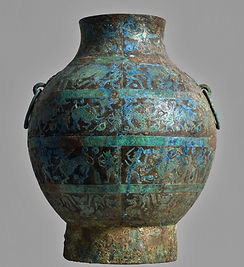
VESSEL HU (JAR)
Western Zhou Dynasty
453/221 BC.
Bronze
Cernuschi Museum, Paris
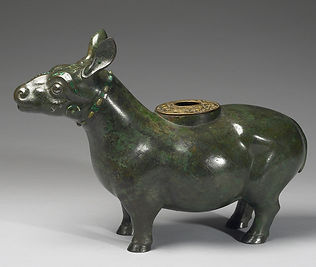
RITUAL ZUN WINE VESSEL IN THE SHAPE OF ANIMAL
Mid Warring States period, 376-375 BC.
L. 39.5 cm ;H. 29.0 cm
Metal wire and turquoise inlay
National Palace Taipei, Taiwan
%2C%20481%E2%80%93221%20BC%20Chinois%20Cleveland_e.jpg)
VESSEL HU (JAR)
Western Zhou Dynasty (771-256 BC.)
481–221 BC.
Bronze, H. 25.5 cm
The Cleveland Museum of Art, United States
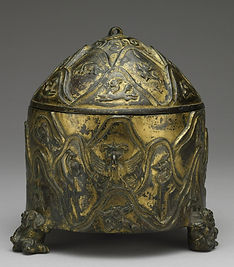
RITUAL VESSEL, 'TSUN'
Western Han Dynasty (23-220)
Bronze, H. 19.6 cm
National Palace Museum
Taipei, Taiwan
2. . From the Shang Dynasty (1600-1050 BC) to the end of the Eastern Zhou Dynasty (771-256 BC), bronze was associated with funeral rites. More bronze was used for ritual vases than for weapons, and far more than was used by peasants and craftspeople for their tools. This indicates both the great value attached to ritual practices at this time, and the protective forces thought to be attached to the rites for which these bronzes were used. The bronzes, mostly ritual vases, were created for celebrations where the dead – powerful aristocrats – were summoned.
3. The Chinese zun is a type of bronze vase which can be round (as here), square (see above) or shaped like an animal (see below). Zun were used in religious ceremonies, where they held fermented drinks – offerings to the dead.
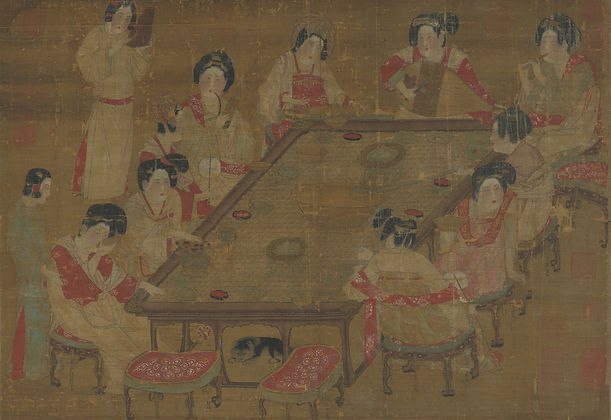
COURT LADIES ON A PALACE CONCERT
China, Tang Dynasty (618/907), between ca. 836 and ca. 907
Ink and color on silk
48.7 cm x 69.5 cm
National Palace Museum, Taipei, Taiwan / 1
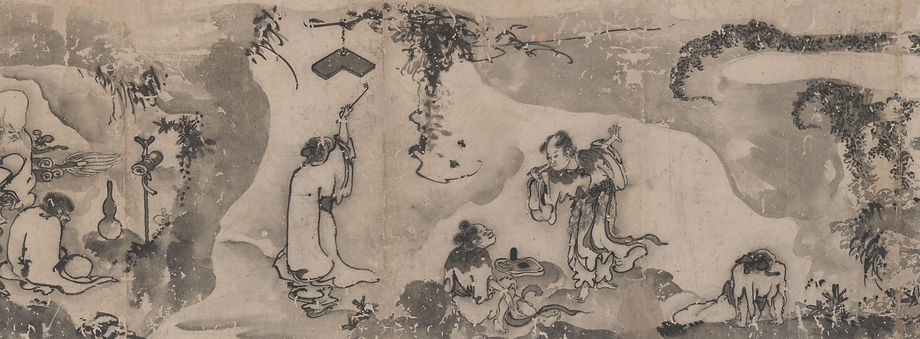
MERRY GATHERINGS IN THE MAGIC JAR
Gong Kai, Dynastie Song (960–1279)
Handscroll; ink and color on silk
29,8 x 431.8 cm
The Metropolitan Museum of Art, New York
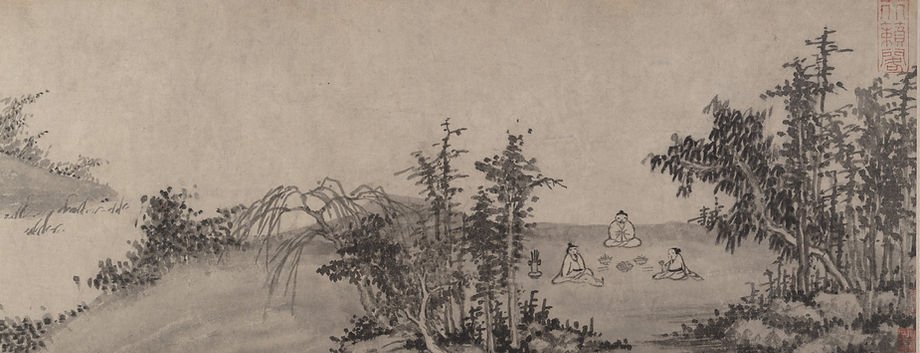
DRINKING AND COMPOSING POETRY
Yao Shou, Ming Dynasty (1368–1644), 1485
Handscroll; ink on paper
23,3 x 77,2 cm
The Metropolitan Museum of Art, New York

GATHERING AT THE ORCHID PAVILLION
Ming Dynasty (1368/1644), Qian Gu, 1560
Handscroll; ink and color on silk
24.1 x 435.6 cm
The Metropolitan Museum of Art, New York / 4

THE EIGHT DRUNKARDS
Anonymous, China
Ming Dynasty (1368/1644) or Qing Dynasty (1644/1911)
Handscroll; ink and color on silk, 21.6 x 233.7 cm
The Metropolitan Museum of Art, New York

IMMORTAL IN SPLASHED INK
Song Dynasty, 13th century
Album leaf, ink on paper
48.7 x 27.7 cm
National Palace Museum, Taipei, Taiwan / 6
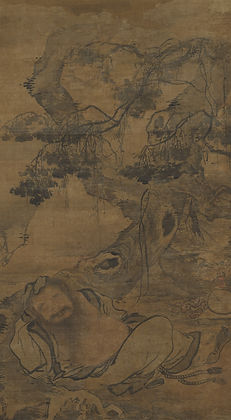
DRUNKEN RECLUSE BENEATH AN OLD TREE
Ming Dynasty (1368/1644), early 16th century
Hanging scroll; ink on silk
175.3 x 102.2 cm
The Metropolitan Museum of Art, New York
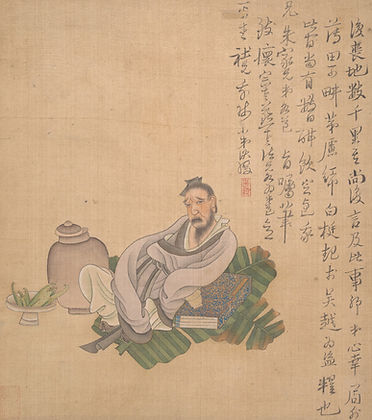
FIGURES, FLOWERS, AND LANDSCAPES
(The artist is drowning his sorrows in wine), 1627
Album of eleven leaves; ink and color on silk
22.2 x 21.7 cm
The Metropolitan Museum of Art, New York
FAIRY AND CRANE
Qing dynasty (1644–1911), 18th century
Embroidery with silk, pearls, and coral beads
65.41 x 37.47 cm
The Metropolitan Museum of Art, New York / 12

DWELLING AMONG MOUNTAINS AND CLOUDS Gong Xian
Qing Dynasty, 17th c.; Ink on paper; 325.1 x 112.4 cm
The MET, New York / 9
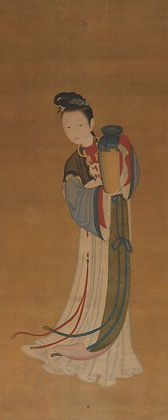
GIRL BRINGING JAR OF WINE
Qing Dynasty (1644–1911), 17th cent.
Hanging scroll; ink and color on silk
147.3 x 65.4 cm
The Metropolitan Museum of Art, NYC

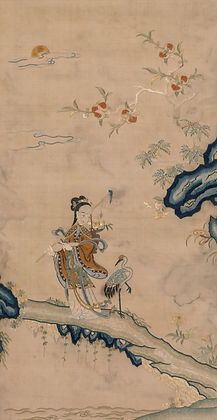
DRUNK IN AUTUMN WOODS
Shitao (Zhu Ruoji), ca. 1702
Hanging scroll; ink and color on paper
161.0 × 70.5 cm
The Metropolitan Museum of Art, NYC / 11

PORTRAIT OFE SHAOYU IN THE GUISE OF LIU LING
Anonymous, ca. 1795
Handscroll; ink and color on silk
36.5 × 156.8 cm
The Metropolitan Museum of Art, New York / 13
1. A Concert at the Palace is a silk painitng which depicts ten ladies of the court and two servants [standing]. Some of the women are drinking tea, while others enjoy wine. The four women at the other end of the table appear to be musicians.
4. In 353, the renowned calligrapher Wang Xizhi and his friends met at the Orchid Pavilion (at Shanyin, in modern Zhejiang Province) to celebrate the spring festival of purification. Sitting by a stream, they held a poetry competition. When the time was up, eleven men had finished two poems, and fifteen had finished one; the sixteen who failed to come up with anything (among them, Wang’s son Xianzhi) were penalized by having to drink three additional cups of wine. In Qian Gu’s representation of this famous literary event, cups of wine float downstream as the poets, lined up on both sides, drink freely and struggle to complete their poems.*
6. An immortal figure strides forward, either stupefied with drink or overwhelmed with joy.
9. 'Where I dwell white clouds often crowd; But only deer travel my just-opened mountain path. How wonderful to bring wine up to the pavilion; Letting go a pure song in the shadows of the setting sun.'*
11. The exhilaration experienced by the friends was inspired by nature, poetry, conviviality, and creativity as well as wine.*
12. The young lady walking on a bridge, carrying a long-handled sickle and a basket of plants, and accompanied by a white crane, may be Magu, a famous Chinese fairy who symbolizes eternal youth. She brews immortal wine from magic plants, such as those in her basket.*
13. This is an example of a type of portrait that became popular in the seventeenth and eighteenth centuries, in which the sitter plays the role of a famous historical or legendary figure. Here, the subject, identified only by his sobriquet, Shaoyu, appears in the guise of the drunken scholar Liu Ling (221–300), who turned to wine to escape the tumultuous political environment of his day. Liu is remembered as one of the Seven Sages of the Bamboo Grove, contemporaries who renounced worldly affairs for the simple pleasures of drink, music, and poetry. Following standard depictions of Liu, Shaoyu rides in a deer-drawn carriage and is accompanied by attendants, one of whom carries a spade to bury the master on the spot should he die from dissipation.*
* Source: The Metropolitan Museum of Art, New York
KOREA
Written sources indicate vine cultivation on the Korean peninsula dating back only to the 17th century (shipwrecked in Korea in 1653, a Dutch trader wrote in his travel journal of allowing the Koreans he met to taste wine for the first time). However, “grape wine” may have been introduced here during the Mongol Empire, between the 13th and 14th centuries.
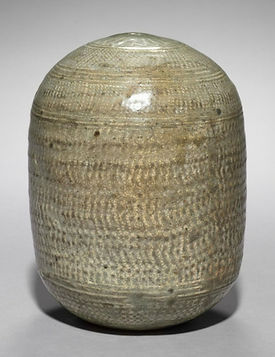


WINE KASK WITH STAMPED FLORAL DECORATION
Joseon Dynasty (1392-1910), 1400s
Pottery
19.8 cm
The Cleveland Museum of Art, United States
PRUNUS VASEwith Inlaid Clouds and Flying Cranes Design
Goryeo period (918-1392), 1300s
Celadon
37 cm
The Cleveland Museum of Art, United States
WINE FLASK WITH INCISED AND SGRAFFITO PEONEY DESIGN
Joseon Dynasty (1392-1910), 1500s
Stoneware with incised design (Buncheong ware)
22.6 cm
The Cleveland Museum of Art, United States

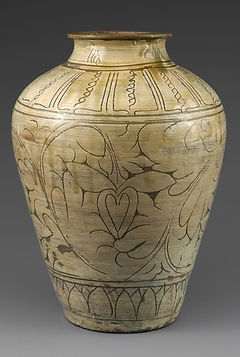
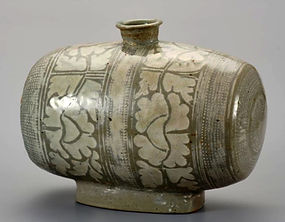
ELEPHANT-SHAPED RITUAL VESSEL WITH TORTOISE MOTIF
Joseon Dynasty (1392-1910), late 14th/late 16th centuries
Buncheong ceramic
25.1 x 41.3 cm
National Museum of Korea, Seoul
JAR WITH PEONY AND SCROLL MOTIF
Joseon dynasty (1392–1910), Late 15th century
Buncheong ceramic
42.7 x 31.8 cm
National Museum of Korea, Seoul
BARREL-SHAPED BOTTLE WITH PEONY MOTIF
15th century
Buncheong ceramic
15.9 x 22.2 cm
National Museum of Korea, Seoul
.png)
POEM AND WINE
Yi Gyeong-yun, 1545/1611
Ink on ramie (,ettle in China)
22.5 x 23.3 cm
Horim Art Center, Seoul, South Korea

GRAPEVINE
Anonymous, 1600s
Ink on paper
98.5 x 29.5 cm
Private collection
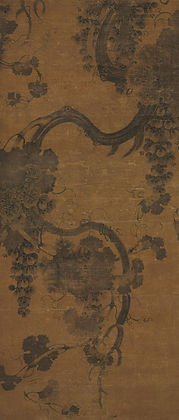
GRAPES
1700s
Hanging scroll, ink on silk
101 x 47 cm
The Cleveland Museum of Art, United States
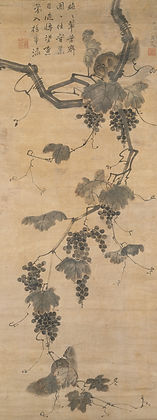
GRAPEVINE AND SQUIRRELS
Early 19th century
Hanging scroll; ink and color on paper
137.2 x 57.8 cm
The Metropolitan Museum of Art, NYC
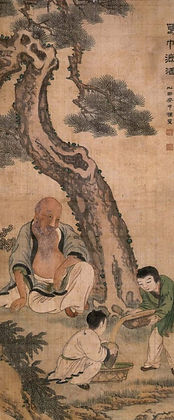
DRINKING WINE STRAINED THROUGH A CLOTH CAP
Ahn Jung-sik, 1861-1919
Light color on silk
120.8 x 56.0 cm
Korea Data Agency, South Korea
GRAPEVINE
Choe Seok-hwan, 19th century
Ink on paper
58.4 x 34.3 cm (each painting alone)
Kang Collection Korean Art, New York

POET FISHERMAN
Korea, 1800s
Album leaf from a set; ink and color on silk
22.5 cm x 24.0 cm
The Cleveland Museum of Art, United States

GOING TO LISTEN TO SONG OF THE NIGHTINGALE WITH A BOTTLE OF WINE
Jo Seok-jin (1853-1920)
Light color on paper
24.7 x 28.8 cm
Korea Data Agency, South Korea
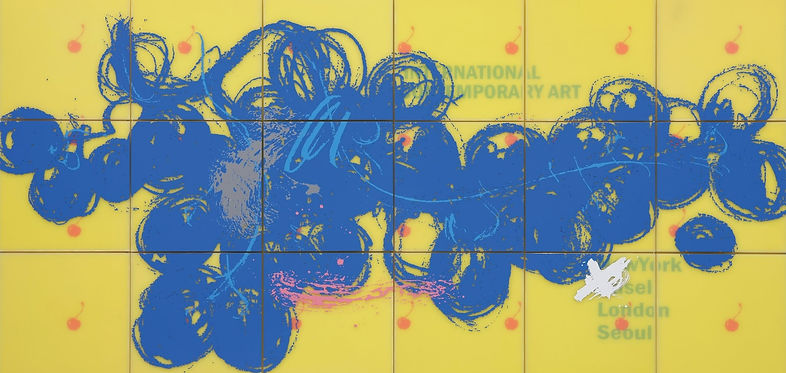
BLUE GRAPE
Jonak Kim, 2009
Urethane paint on face & back acrylic
180 x 360 cm
Korean Art Museum Association, South Korea
JAPAN
Vine cultivation in Japan dates back to the 18th century. The grapes produced were mainly eaten. Later, Buddhist missionaries would spread vines across the country, but with little intent of promoting wine production. In the 16th century, European wine was imported for consumption by the Japanese elite. In later centuries, isolationist politics led to a ban on such imports.


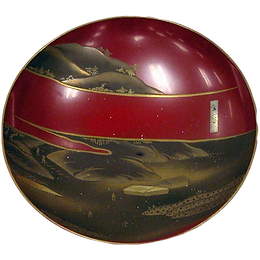
ONE OF A PAIR OF WINE CUPS (SAKAZUKI) WITH MOUNT HORAI
Edo period (1615–1868), 19th century
Lacquer
Diam. 11.7 cm
The Metropolitan Museum of Art, New York
WINE CUP
Edo period (1615–1868) or Meiji period (1868–1912), 19th century
Red lacquer decorated with gold
14 cm
The Metropolitan Museum of Art, New York
WINE CUP
Edo period (1615–1868) or Meiji period (1868–1912), mid-19th century
Lacquer
7.9 cm
The Metropolitan Museum of Art, New York
.jpg)

THE EIGHT IMMORTALS OF THE WINE CUP
Edo period (1615–1868), end of the 18th century
Pair of six-panel folding screens, ink and cut-gold foil on paper
Overall: 120 x 352.2 cm
The Cleveland Museum of Art, United States / 4
4. The theme of “Eight Immortals of the Wine Cup” is based around a work by Du Fu, a famous Chinese poet of the eighth century. In the poem, Du Fu refers to his eight colleagues, who have shaken off their official government positions and fled the capital for the countryside. High-spirited and carefree, they now allow their eccentricity and creativity to run wild, fuelling their exploits with great quantities of wine.

THE GIRL COMMONLY CALLED UNCONTROLLABLE
Japan, Kitagawa Utamaro, ca. 1802
Woodblock print, ink and color on paper
36.7 x 23.5 cm
Honolulu Museum of Art, Hawaii, United States
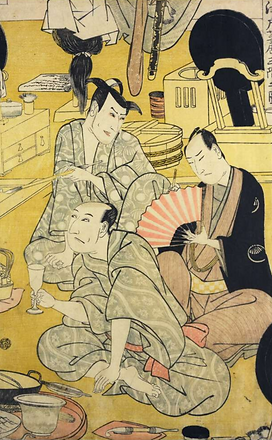
KABUKI ACTORS RELAXING IN THE THIRD FLOOR DRESSING ROOM
OF AN EDO THEATRE
Kitagawa Utamaro, ca. 1802/03
Colour woodblock print, oban triptych
British Museum, London

WINE CUPS
AFLOAT ON MEANDERING STREAM
Yokoi Kinkoku, 1815; Ink and colour on silk; 108.50 x 36.20 cm
British Museum, London
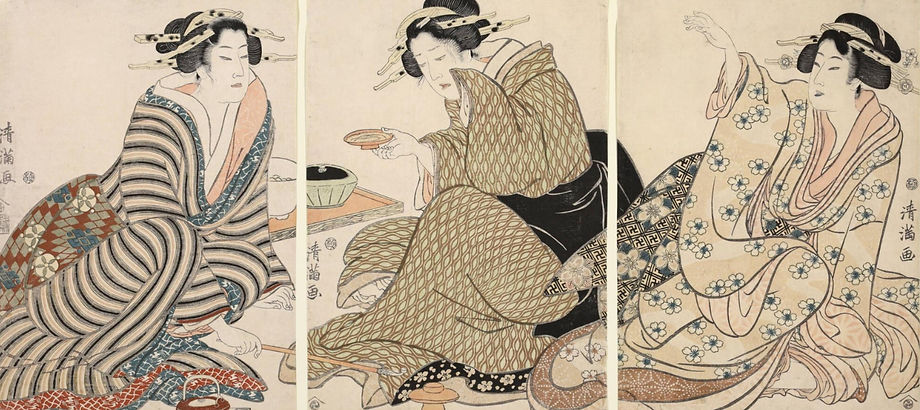
COMPANIONS FORCING A GEISHA TO DRINK FOR A CUP OF WINE,
PERHAPS AS A FORFEIT FOR LOSING A ROUND OF A HAND GAME
Torii Kiyomine, End of 1810s; Color woodblock print; ink and color on paper
34.3 x 72.2 cm
Allen Memorial Art Museum, Oberlin, Ohio, United States
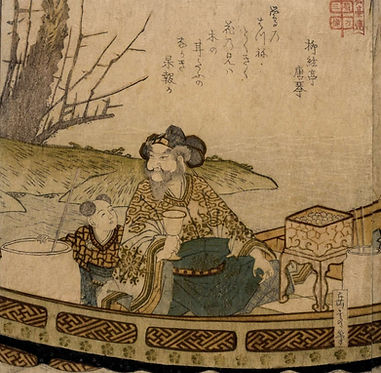
WITH WINE AND BOOKS ON BOARD (from a diptych)
Yashima Gakutei
1786-1868
Woodblock print
British Museum, London
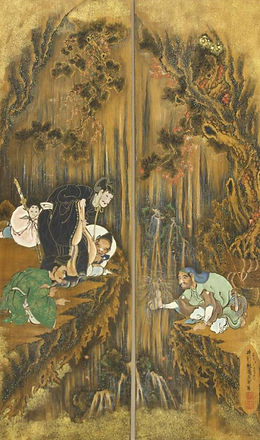
WOODCUTTER SHOWING TO THE EMPEROR A GOURD CONTAINING THE WATER CHANGED INTO WINE
IIkawa Kaian Eisai, 1852; Ink, colour and gold on two wooden panels, 104.00 x 34.70 cm (each)
British Museum, London
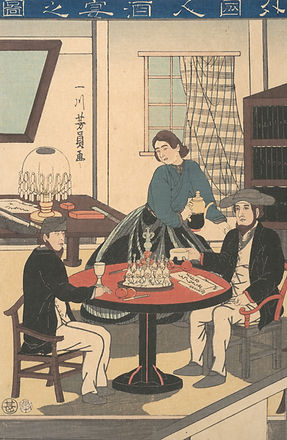
FOREIGNERS AT HOME: A WINE PARTY
Utagawa Yoshikazu, 1860
Woodblock print; ink and color on paper
34 x 22.9 cm
The Metropolitan Museum of Art, New York City

[FRUNK] ENGLISHMAN RAPING A WINE SHOPKEEPER'S DAUGHTER Tsukioka Yoshitoshi, 1875, newspaper
Woodblock print; ink and color on paper
35.9 cm x 23.8
The Metropolitan Museum of Art, New York

SAKATA KINTOKI DRINKING WINE (Sake)
Attributed to Katsushika Hokusai, 18th-19th century
Ink and color on paper
23.8 x 35.4 cm
The Metropolitan Museum of Art, New York / 11
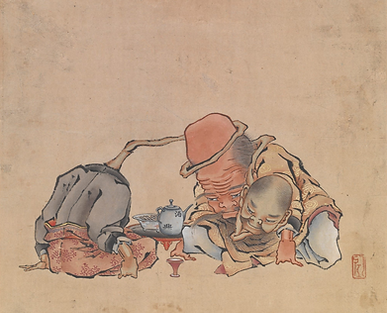
DRINKING WINE
Attributed to Katsushika Hokusai
18th-19th century
Ink and color on paper
Indianapolis Museum of Art

THE POLICE SUPERINTENDENT AND HIS MEN RECEIVING WINe (sake)
Tsukioka Yoshitoshi, Meiji period (1868–1912), 1877
Triptych of woodblock prints; ink and color on paper
34.3 x 72.4 cm (each print)
The Metropolitan Museum of Art, New York

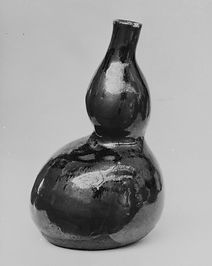

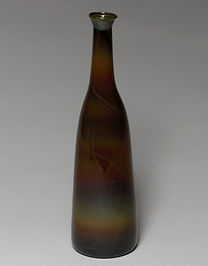

BOUTEILLE DE VIN
Epoque d'Edo (1615-1868), XVIIe siècle
Portterie
17,8 cm
The Metropolitan Museum of Art, New York
BOUTEILLE DE VIN
Epoque d'Edo, 1720
Porcelaine
22,2 cm
The Metropolitan Museum of Art, New York
BOUTEILLE DE VIN
Epoque d'Edo (1615-1868), mi-XIXe siècle
Verre
22,2 cm
The Metropolitan Museum of Art, New York
BOUTEILLE AVEC CAVITE
POUR VERRE DE VIN
Koichiro Yamamoto, 1999; 27 cm
National Museum of Scotland
Edimbourg

POMEGRANATES AND GRAPES
Kobayashi Kiyochika, 1879/81
Woodblock print; ink and color on paper
35.5 X 24.0 cm
Minneapolis Institute of Art, United States












